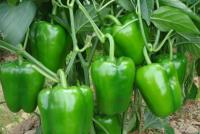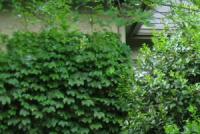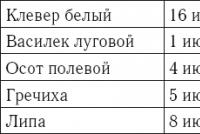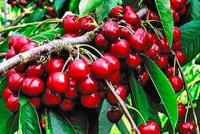Rules for creating green space. Standards and regulations. Green areas: what it is, types and role
Depending on local conditions, fruit trees are planted in spring, autumn and winter. Spring and autumn plantings are possible in any years, and winter - only under favorable weather conditions.
The choice of planting dates is determined by the biological characteristics of the crop, the soil-optimum conditions of the zone, the degree of resistance to low winter temperatures, and the organizational capabilities of the farm.
The success of planting trees depends on how the regeneration and growth of new roots, the establishment of their contact with the soil. Better this is achieved during the autumn plantings. Under favorable weather conditions, the processes of wound healing or regrowth of new roots begin at the ends of the trimmed roots (in late autumn and early spring periods). The season of autumn planting in some years can last about 1.5 months.
Usually spring planting lasts no more than 10-15 days. It is determined, on the one hand, by the maturity of the soil, which comes with increasing temperatures, and on the other, by the possibility of planting seedlings before the buds swell.
In the northern and middle zones of horticulture, autumn planting is less reliable due to the danger of damage to trees by low temperatures during winters with little snow. Saplings, wintered in prikpochnyh areas, better preserved from damage by frost and rodents. Therefore, more often in the fall they plant an apple tree on seed rootstocks, and stone fruits, pear, quince and apple trees on vegetatively propagated rootstocks are planted in spring.
Winter garden planting is permissible in the southern regions and only during warm and relatively dry periods when the soil dries out so that it can be treated. Most often, such weather conditions are suitable for repairing green spaces. The soil during the winter plantings should not be frozen, as well as excessively moist.
Preparation of seedlings for planting. From the quality of planting depends on the survival of trees in the garden, their growth and yield.
For planting, use only healthy, standard, grown on stable, zoned for this zone stocks, seedlings free from pests and diseases, especially quarantine (California shchitovka, etc.).
Some varieties and at the age of one year form crown well. Therefore, even in the middle zone, kronous annuals can be successfully used for planting seed seeds on a strong-growing stock.
When transporting seedlings need to protect the roots from drying, freezing and mechanical damage. Before planting, seedlings are inspected, poor ones are rejected, and broken or damaged roots and twigs are cut out on suitable for planting. The root system is immersed in a glinton-wagger talker, where it is desirable to add heteroauxin, which stimulates the formation of new roots and increases the survival rate of seedlings. Spring seedlings pruned.
Ways and technology of landing. Currently, there are several ways of planting a garden: manually (into pre-dug pits), along furrows, trench, under hydroborer and mechanized.
Manual planting in public gardening is mainly used when it is necessary to plant a plot, in repairing sparse plantings, as well as in laying a small plot.
Planting depth depends on the type of stock, preplant tillage, etc. Saplings are planted to such a depth that the root neck is at the level of the soil surface. With deep planting in the soil, in a humid and poorly aerated environment, the above-ground part of the tree turns out to be. This adversely affects the growth and condition of the tree. On heavy soils, the trunk bark can be sub-ripe, therefore trees are planted 2-3 cm deeper than the root collar, according to the freshly plowed up plantation.
Planting pits are dug up to 60 cm in depth with the KLU-100 hole-diggers (diameter of interchangeable drills - 30, 60, 80 and 100 cm), KPNL-60 (30 and 60 cm) or KRK (20, 40 and 65 cm). In dry zones, it is better to dig holes before planting, so that they do not dry out, and in wet areas, you can advance.
If the main fertilizer was used for the plan, then they are not placed in the pits when planted.
When planting soil sapling is usually somewhat deeper. On light soils (sandy, pebbly) it is better to plant trees 6-8 cm deeper than the root collar. This improves the water regime of the root system. Plant seedlings grown with an intercalary insert of a vegetatively propagated stock are planted deeper. In this case, in order to ensure greater stability of the fruit tree, it is planted at 1/2 the length of the insert, but not deeper, otherwise the roots are formed on a strong-growing rootstock and this will increase the growth of the tree.
With a small landing on the surface of the root system, which in the snowless winters can freeze, and the diseased part forms on the main axis of the tree - bob growth occurs. All this weakens the trees, they are more damaged by pests and diseases, are stunted, they do not bear fruit well, they die.
When planting trees, it is important to observe the lowercase straightness of the rows. If this is neglected, then all further processing of the rows between the mechanisms will be difficult. It is desirable to observe the straightness of the trees in the transverse direction. This allows the mechanized processing of the garden in the first 2-3 years in two directions. Regardless of the zone after planting, seedlings are watered at the rate of 3-4 buckets per tree. If they are not watered, then the resulting voids around the roots will lead to their desiccation and death, the tree may not settle down.
On dwarf and semi-dwarf, as well as seed rootstocks (when small distances between trees in a row are necessary), a method of planting seedlings along furrows is used. A CRN-4.2 cultivator is marked across the site, and a PRVN-2.5 plow with a depth of 22-25 cm is cut along the entire row of furrows. Saplings are planted manually at the intersection of the marker lines and furrows. However, this method of planting can be applied only on a pre-raised deep plantazhu on powerful soils.
When laying a garden with saplings at one-year age, a hydrodrill can be used. This method of planting is inconvenient for the contractor, since here you need to apply physical force, however, the root system of the seedling with such a planting is sufficiently provided with moisture.
Mechanized landing. For planting fruit plantations used gardening machine MPS-1. It is aggregated with tractors DT-75, DT-75M or T-74, equipped with a creeper gear.
The machine consists of a furrow divider, two zagorcha, two platforms for seedlings, irrigation system, two markers and track indicators. For the free installation of seedlings on the bottom of the furrow in the back of the base of the saucer, a semicircular cut is made. Zagortach close up and compacted seedlings in the soil. Water tank is used for portion irrigation of the root system of seedlings in the planting zone. It is filled with water coming from the main tank.
Brought seedlings are temporarily instilled at the ends of the rut. If the farm has a sufficient amount of transport, then seedlings for loading the machine are fed immediately from it.
Before starting work, the machine is installed on the depth of planting, which should correspond to the size of the root system. With the machine loaded with seedlings, a tractor driver drives up to the originally mounted row and lowers it into working position. At the first signal of the planter-driver, the tractor driver starts the movement of the planting unit. The donor takes a sapling and passes it to a planter who lowers it into the coulter's chamber and at the time of crossing with the transverse furrow puts the plant roots to the bottom of the planting slot. At the same time, the roots press on the dipstick of the irrigation tank, overturn it, pouring over the planting site of the seedling. Balancing the load installed on the opposite side, returns the tank to its original position, after which it is again filled with water.
The marker is designed for applying a well-visible line (groove) when the unit is working on the field, previously marked in the transverse direction.
Departure of the marker and a follower set depending on the width of the aisle.
A track indicator attached to the tractor front bar makes it easier to drive the tractor parallel to the previous aisle.
When planting, each seedling must be held with a hand with a slight inclination against the movement of the tractor until the roots are completely covered with soil. The soil moves to the planting slot with left- and right-sided mortars. 2-3 workers follow the machine, who straighten the tilted trees, compact the soil around each planted tree with their feet, and make shovels for watering with shovels, since the water supplied by the machine during planting is not enough for survival of the planting material. Irrigation holes can be cultivated with cultivators with two hillers, which form rollers in the transverse direction.
After planting, the trees are watered with a liquid fertilizer spreader type RZhT-4, tank truck ZZHV-1,8, to which are attached 2 hoses with tips, water spreader BP-3M, as well as tank trucks ABB-3,6, AU-3. The planting machine is served by 5 people: a tractor driver, 2 planters and 2 operators. The performance of the landing machine MPS-1 -7-10 ha per shift. With properly organized work, the quality of planting is good, the survival rate of seedlings is 97-98%.
Labor costs for the mechanized method of planting a garden are 4 times lower than for manual ones.
Mechanized planting of fruit trees is possible in all areas of industrial gardening, with the exception of areas with a small arable layer and a steep slope above 10 ° C.
To further increase labor productivity, improve the survival rate of seedlings on heavy loam overmoistened soils, and make rational use of fertilizers, the trench method of soil preparation, especially in the Non-Chernozem zone, is becoming more common.
The essence of this method lies in the fact that when splitting the plot, the stakes are not installed along the line of the planting line, but laterally, at a distance of 1 m from the landing site. This allows you to dig straight planting trenches at the site of future rows and to carry out all the work with machines on the side of the center stakes. For example, to get a 7-meter aisle, stakes are placed at a distance of 9-5-9-5 m, etc. Such a breakdown allows the tractor driver to make shuttle passes with a planing plow inside a 9-meter row-spacing. The trench is dug at a distance of 1 m from the stakes, 2 m (1 m on each side) is cut off from both sides of the 9-meter row-spacing and the furrows are placed exactly 7 m apart. Organic fertilizers are scattered along the future trench and a double-pass plantation plow is made a cone-shaped trench 150-170 cm wide and 45-50 cm deep. When the plow is working, the fertilizer is mixed with the soil and mineral fertilizers are applied to the bottom of the furrow. They are fed from a bunker mounted on the frame of a plantation plow.
After fertilization, the trench is closed with a bulldozer with an oblique blade or with a special device, which are two symmetrically located grader-type heaps, which are raked, mixed and dumped the soil into the trench. Then a gardening machine passes through this lane.
In the autumn, after planting irrigation, trees are spudding with the help of a plow, in which the rear case is deepened weaker than the front one. Due to this, along the row of trees formed svalnoe furrow. In the spring of her fall down garden discs.
Planting fruit plantations
Planting trees and shrubs is one of the crucial steps in creating landscaping objects. In landscape gardening construction, landing works are carried out in strict accordance with the design and estimate documentation for the special landing drawings drawn up on the basis of the master plan and dendroproject (Fig. 10).
Fig. 10. An example of a landing drawing for a part of the landscaping object.
With the help of planting drawings and statements of planting material determine the range of plants, their number, size and age, sources of production, planting sites, ways of carrying the project in nature, the size of planting pits and trenches, the need for plant-nutrient soil mixture for planting.
Sources of planting material are nurseries of tree and shrub ornamental species, forest nurseries in the suburban area, plantings from building sites intended for transfer to other landscaping objects, etc. Sources of planting material for landscaping are examined in advance, provides for the construction of entrances to the places of growing plants.
In accordance with the purpose of the object of landscaping or its planning element, planting material of various ages and sizes is used.
When creating forest arrays in large parks, forest parks, recreation areas, one-two-year-old seedlings and saplings of three to four years are used. Planting is carried out by means of forest crops with the help of tree-planting machines with the placement of plants, providing the mechanization of planting maintenance.
When creating groves, curtains, groups of plantings in gardens and parks, residential buildings, as well as lanes on the residential streets of small cities and towns, standard saplings of trees and shrubs are used at the age of 4-12 years.
When landscaping highways, community centers, areas use large-sized trees at the age of 15-20 years; landing is carried out in accordance with the project on strictly permanent seats. Planting technology should help maintain the plant in a physiologically active state and the rapid recovery of the body after planting in a new place. The best time for planting is spring and autumn, when the plants are in a natural non-individual state or in a state of reduced activity of the physiological processes of the plant organism. Planting work is carried out in stages for a certain period of time and is divided into work on the preparation of plants for transplantation in the nursery, associated with digging seedlings, their packaging, installation for transportation to objects; transplant work, including loading onto motor vehicles, transporting to landing sites, directly landing in pre-prepared landing pits, pits or trenches; work on post-plant care of plants during the period of survival, which lasts 2-3 years from the time of planting.
Of great importance for the normal functioning of plants after planting are the density of planting and the distance between trees and shrubs. In the project it is necessary to provide for planting plants in permanent places. The distances between plants in urban gardens and parks when planting in arrays should be 3.5-6 m. In the lanes on the streets, in the public gardens, in the residential area, trees are placed so that with the growth and development of their crowns could develop freely in space and do not oppress each other in adulthood; at the same time, wide-crown trees are recommended to be placed at a distance of 4-8 m, and narrow-crown - 2.5-5 m from each other. It is necessary to consider the norms of planting trees and shrubs per unit area of the object, depending on its purpose, as well as the climatic conditions of the area. Modern standards of gardening provide for and consider the placement of 90-150 trees per 1 hectare of the green area of the common object to be considered sufficient. The ratio of trees and shrubs averages 1: 7 - 1:10. All types of transplanted plants and the category of planting material require certain sizes of seats, depending on the size of the root systems of seedlings. Planting depth is essential for a variety of plant species.
Post-plant care for trees and shrubs is a system of measures aimed at restoring the vital functions of plants after transplantation and speeding up the process of adaptation to adverse environmental conditions. Woody plants transplanted from nurseries to urban urbanized environment, find themselves in extremely adverse habitat conditions. They experience the effects of a variety of environmental factors - insufficient or excessive lighting due to shading or vice versa, being in the open, local winds or drafts, elevated air temperature as a result of asphalt heating, gas pollution, soil compaction. Measures for post-care care, first of all, should be aimed at restoring the plant body and eliminating the adverse effects of the external environment. The focus should be on caring for the root system of a plant by introducing growth stimulants into the zone of root systems simultaneously with irrigation. During the season, the plants must be watered 7-10 times depending on the weather. In dry and hot weather, along with irrigation, it is necessary to irrigate the aerial parts of plants, which helps to clean the leaves of dirt and increase the intensity of photosynthesis.
Weeding and loosening the surface around planted plants are important post-plant care measures. Loosening contributes to interrupting the rise of water through the capillaries of the soil from the root layer, enhancing the air and water permeability of the soil surface, and destroying weeds.
The period of survival of plants, the restoration of their life after transplantation for different types of plants can be different. Post-planting care should be aimed at reducing plant survival time; criterion survival is the formation of resistant shoots of plants, the growth of leaves, their juicy green color, the timeliness of plant entry into the rest period, the intensive growth of shoots in the next year, the ripening of their wood in autumn.
When caring for trees and shrubs at landscaping sites, it is necessary to take into account the specifics of the air and soil environment. Mineral nutrition of plants, the use of biologically active chemicals, carrying out agrotechnical care, taking into account the peculiarities of crown growth and development of root systems, can improve the water and air regime and metabolism of plants, ensure their viable condition. Providing plants with the missing nutrients occurs due to the introduction of organic and mineral fertilizers. Fertilizers are applied by surface spreading, in a focal way, in wells of 20–25 cm in depth, 4–5 cm in diameter, 3–5 pieces per 1 m2 of the surface, and also in the form of liquid mineral supplements.
In addition to fertilizing, they systematically irrigate and mulch, loosen pristvolnyh sites, and insulate root systems for the winter. These measures are used in the first years after planting as they adapt to new conditions.
Caring for the aboveground part of the plant consists in taking care of the trunk of the tree, pruning the branches and shoots of the plants in order to form the crown and improve it.
Preservation of plantings in a viable state in an urbanized environment at various greening sites is one of the main tasks of organizing urban green economy. The solution to this problem is based on the development of rational methods of care and the introduction of advanced technologies. The agrotechnology of caring for urban plantings should be differentiated, mobile, taking into account the biological and environmental requirements of plants on the basis of a preliminary diagnosis of their qualitative state.
Construction and maintenance of lawns, flower beds and landscape structures
Cultural lawn - This is an artificial turf cover created by growing various types of grass, mainly perennial cereal species. There are three types of cultivated lawns:
· Sports, staged at stadiums, racetracks, tennis courts, playgrounds for games;
· Special, arranged at the airfields, slopes of highways and railways, hydraulic structures;
· Decorative, created on objects of gardening - in gardens, parks, squares, boulevards, forest parks, on objects of residential and industrial building.
Decorative lawns are divided into parterny, ordinary or landscape, meadow or mixed, flowering.
Parterny lawns arrange for the foregrounds landscape gardening compositions, at the entrances to public places, around monuments, etc. Such a lawn is usually created from one or two types of grass, which form a uniform grass stand.
Ordinary landscape lawns constitute the largest part of the turf cover of gardens and parks. The turf of such a lawn should be tearproof, resistant to damage. For the creation of such a lawn, cereal grasses with various types of tillering are applicable: rhizomatous, rylokustovye and rhizomatous rykhlokustoye. At the same time use a mixture of three to five types of herbs.
Meadow Lawns they arrange parks and forest parks at large sites, as a rule, by improving existing grass stands of natural origin.
There are several ways to create lawns depending on their purpose:
· Sowing lawn grass seeds on the prepared surface;
· Hydroseeding - application of seeds to the prepared surface in the form of special solutions;
· Odnovka or layout roll sod on the prepared surface.
Flower beds they are one of the main means of decorating squares, approaches to public buildings, entrances to landscaping objects, as well as the objects themselves - gardens, squares, boulevards. They are created on the principle of landscape or regular composition. Landscape flower compositions include flower groups, arrays, flowering lawns, usually created from perennial plants of various shapes and sizes. Flower beds of regular composition are parterres, stripes, flower beds, curbs, usually located on the streets, driveways, squares, and in public buildings.
Flower gardens as an effective method of landscaping can manifest themselves fully only if all the rules and regulations of agrotechnical plant cultivation are fulfilled. Of great importance are the ecological features of growing plants, as well as the soil and climatic conditions of the area.
Garden and park facilities and equipment are designed to create the most comfort for visitors during their stay at the facility, for the detailed improvement of individual, most interesting places, as well as for the decoration of green areas.
They should be as necessary as possible for visitors, comfortable and perfect in design and form, to complement or shade existing green spaces. Garden and park facilities and equipment are divided into:
· Small architectural forms - park utilitarian and engineering structures intended both for direct customer service and for decoration of the landscape gardening object and to reflect the expressiveness of the relief - features of the vertical planning of the territory;
· Water devices or hydraulic structures that perform an important function in the composition of a landscape gardening object with possible utilization;
· Garden and park equipment - elements of the facility utilitarian and artistic performance.
The structure of structures, the list of equipment, its rational placement depend on the size, purpose and planning features of the landscape gardening object. In city parks and gardens there are all kinds of buildings and equipment. On small objects, especially transit squares and boulevards, the simplest equipment is used: benches, urns, vases, lamps, watch booths, kiosks. In suitable recreation areas and forest parks, the same equipment is used as in urban parks, but made from waste wood raw materials, and it well emphasizes the natural forest landscape. Construction of buildings are carried out according to specially designed projects. According to the working drawings of the vertical layout of the object, ramps, retaining walls, and slopes are arranged. Currently widely used standard designs of buildings and equipment for which the production of prefabricated elements, easily assembled into finished products at the installation site. However, for park facilities and equipment, individual projects are also needed, creating their own unique appearance of the object.
Green spaces - one of the main elements of the landscape. The type of plantations is often determined by their functional task. For example, ordinary plantings (trees or shrubs) are used, as protection from winds in open spaces (you could see such along fields), to separate the yards of apartment buildings from the roads. Any landscape is very much decorated with alleys (ordinary landing on two sides of the road), they are usually created along the road at the entrance to the site and along the internal paths.
Green massifs are a group of trees that imitate the “forest zone”, their placement is advisable on large areas.
In the suburban and garden plots are much more likely to use hedges (well-branching shrubs). Their purpose is to distinguish between different areas of the site among themselves. Usually for such hedges use light-loving, frost-resistant decorative-flowering plants, densely planted in one row (less often two or several rows). These include various types of willows, silver goof, buckthorn buckthorn, spruce (European and prickly), Thunberg barberry, Kamchatka shrub, shiny cotoneaster, hawthorn, white, Japanese.
An interesting and functional use of hedges - bosquets. Bosket are dense plantings of bushes or trees that form solid green walls, they can form spaces closed around the perimeter (“cabinet”), or a dense group of trees or shrubs on the lawn in an open area (“artificial grove”). Such plantings are formed by regular pruning, so that the walls of the “cabinet” take a completely flat shape.
Soliter - single planting of plants, which give the corner of the garden individuality and expressiveness. Each of these plants receives a maximum of light and free space, and therefore the trunk from below will be less exposed (to lose the lower branches and leaves, as it happens in arrays). His crown will be the most developed, sprawling and has more chances to show his natural beauty. A single tree or shrub attracts views, takes the accent, and therefore the most ornamental plants are chosen as a tapeworm.
- decoration of vertical surfaces (walls of houses, arches, arbors, pillars, etc. vertical building elements) with the help of green spaces. As a rule, lianas are used, both annual and perennial. The most common rastanriya, which, probably, everyone saw is a girl's grape, hops, clematis.
It should be remembered that all plants require certain conditions for growth and, with improper care, lose all decorative value.
Returning to the previous topic, it is worth noting that the most important point in the development of landscape design and the selection of green spaces is the forecast of the dynamics of the development of garden vegetation. It is necessary to have an idea how trees and shrubs change and grow over a certain time period. How durable these or other plants are, this is especially important in creating landscape groups.
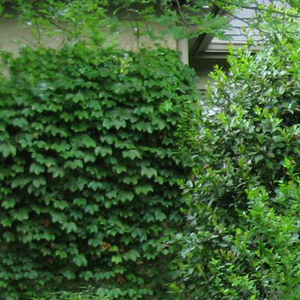 Most often, problems with the garden area arise after several years, when the trees and shrubs grow up, I begin to create shading each other or planted near the flower and berry crops. Therefore, when planning a site, it is necessary to imagine how the vegetation will look on it, say, in 10-15 years.
Most often, problems with the garden area arise after several years, when the trees and shrubs grow up, I begin to create shading each other or planted near the flower and berry crops. Therefore, when planning a site, it is necessary to imagine how the vegetation will look on it, say, in 10-15 years.
As a rule, for planting use large-sized planting material. Those. already podroschennye instances of plants. In one group, plants are selected with approximately the same growth rate so that the development of this landscape ensemble occurs evenly.
An essential design element is the crown of trees and shrubs. It can be natural, dictated by natural conditions, and artificial (created by regular pruning). It should be noted that, depending on the type of plants, the crown may be very dense (good branching), for example, in oak, ash, or elm, or delicate, like willow, ash, larch. Such a crown skips a certain amount of light and creates a slight shading. Although the density of the crown depends on the lighting - the more sun, the thicker the crown.
Trees and shrubs with an openwork crown, especially a weeping form, are most often used in solitary (single plantings), otherwise they lose their attractiveness.
The shape of the crown can be sprawling, creeping or weeping, oval, pyramidal. The option of crown formation depends largely on the type of plant and light intensity.
This topic is very serious, it is worth considering it separately and in more detail. However, there is another kind of gardening that can effortlessly give your garden a noble and well-groomed look in just one season - this is a lawn.

- grounds covered with a thick ground cover layer of perennial herbaceous plants. Lawns can be created in almost any place - light and shaded. They ennoble the most unpresentable corners of the garden, do not allow the weeds to grow and have an extremely favorable effect on humans, and they are pleasing to the eye and are saturated with oxygen. Another advantage of lawns is the cooling effect. On hot summer days, any covering - paving stone, sand, stone paths, and just open ground keep a much higher temperature than lawns.
The most popular landscape gardening lawns are specially selected mixtures of such herbs as red fescue, meadow grass, white meadow, grassland ryegrass. All lawn grasses have a strong root system (forming turf), good tillering and short stature.
Sports lawns must be resistant to trampling, and therefore require some preparation before sowing the grass mixture. At a depth of about 50 cm under the platform for a sports lawn make a continuous layer of drainage of fine gravel or gravel. Then the sand cushion is laid with a height of 7-10 cm, and then the upper fertile layer of the earth is 15-20 cm.
The prepared substrate should settle and lay down, to compact the top layer of the earth using a lightweight manual roller. On the arrangement of the site under the sports lawn takes several weeks. The soil should be so dense that when walking on it there were no depressions from the tracks. When these properties are reached, the soil is ready for planting. Rakes loosen the top 2 cm of soil and sow grass mixture. Then level with a rake and re-compaction roller. In the absence of rain, crops are sown daily, in the evening they are watered using a spray bottle.
Evgenia Gorchakova

